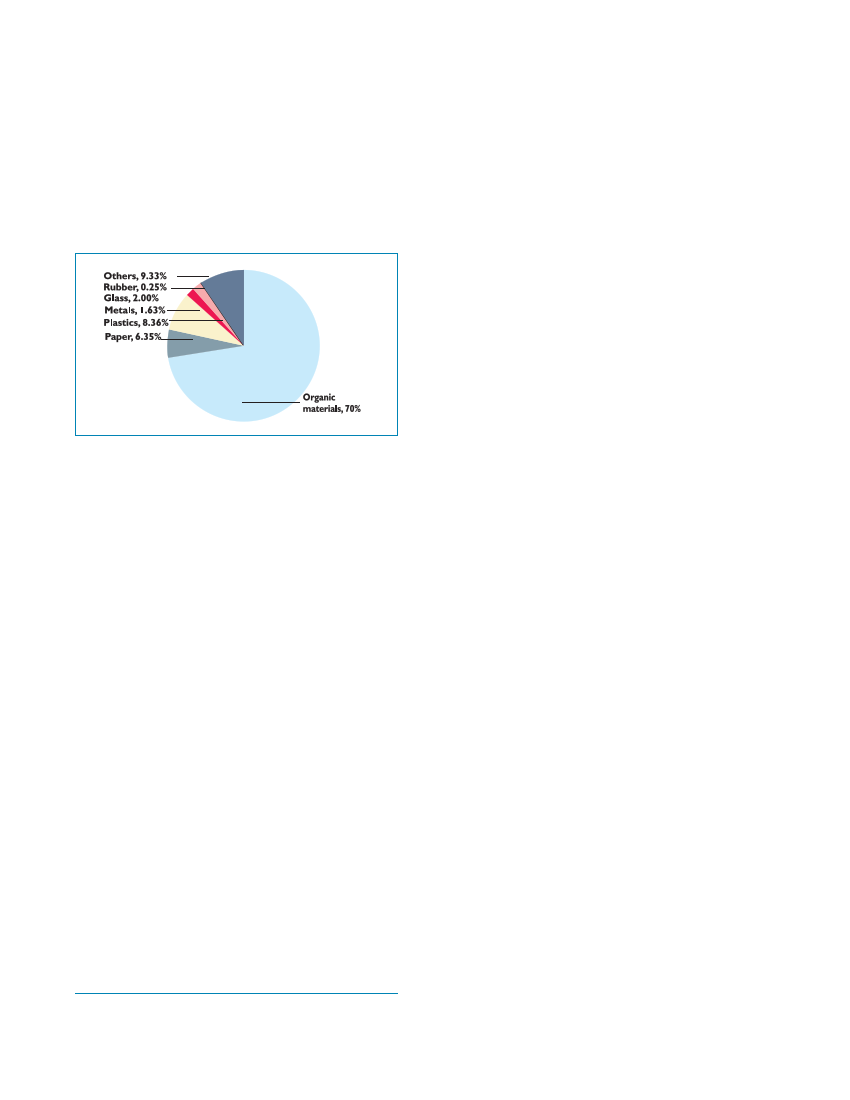
BEST PRACTICES ON SOLID WASTE MANAGEMENT OF NEPALESE CITIES
leather 1 per cent and other materials 8 per cent
(Bharatpur municipality, 2008 data). These data show
that plastic constitutes almost 7 per cent of the waste -
i.e. 1.4 tons/day at source - and it is believed that the
waste being an inorganic matter will remain in the
environment for a long period.
Chart 7: Composition of solid waste at source
from the city centre and 4.5 km towards the eastern side
(jungle area) of Ramnagar Bazaar. Plastic wastes that
cannot be recycled are transported by the Suiro
Programme to the dumping site designated by Bharatpur
municipality using the rickshaws (Suiro Programme,
2008 data). The contractor of Bharatpur municipality
takes the remaining wastes to the dumping site. The
contractor29 dumps all kinds of waste but the Suiro
Programme dumps only plastic which can not be recycled.
The municipality takes care of the dumping site.
Waste collection and recycling
Initially the Plastic Entrepreneurs' Committee had
distributed Suiro hooks to 2,000 HHs in the main market
area of Bharatpur (SWMRMC, 2006 data). This initiative
became a source of inspiration for plastic waste
separation. Women's groups from TLO have distributed
suiro hooks to HHs and collected plastic waste on a
monthly basis. The Suiro programme collects 1-1.2 tons
of plastics every month from the eight wards within
Bharatpur municipality. The recovered plastic sells for
NRs.10/kg (Suiro Programme, 2008 data).
Two rickshaws that can carry loads ranging from 300
to 500 kg are used to collect recovered plastic waste
from eight wards, (comprising approximately 6,000 HHs
and 500 shops (Suiro Programme, 2008 data). Residents
living in the selected areas are given a Suiro hook at
no charge. With the partial support from Practical
Action in Nepal, various training activities, field visits
and speech competitions were conducted.
Transport and final disposal
Since 2006, Bharatpur municipality has been dumping
its waste at Ramnagar dumping site. The site is 11km
Organisational and
financial aspects
This programme has demonstrated that, with adequate
motivation, a considerable income can be generated from
solid waste. Four full-time collectors and one office
secretary are engaged for plastic collection and the
associated administration. They collect around two tons
of plastics every month, out of which 1-1.2 tons of plastics
can be sold. The total income from plastic recycling is
NRs.30,000/month (Suiro Program, 2007 data). Each year,
Suiro donates approximately NRs.50,000 to handicapped
people, poor students from various schools and low-
income HHs in various slum and squatter communities
within the municipality.(Suiro Programme, 2007 data).
Major problems and issues
The Suiro programme has not only had a beneficial
impact on the environment but has also assisted the
women involved in this initiative. Women are
developing the skills and confidence to be able to speak
in front of large groups to share their knowledge and
feelings. Women are learning to recycle waste at the
HH level; they are also working together to build social
ties with other communities. This activity has
disseminated knowledge on at-source waste reduction.
Despite these successes there are still obstacles, among
them, poor public cooperation and the lack of sufficient
transportation.
Nevertheless, this programme has definitely achieved
its goal of reducing the amounts of plastic waste in
Bharatpur municipality.
29 Municipal Solid Waste Management of Bharatpur municipality is discussed in an earlier
case.
34